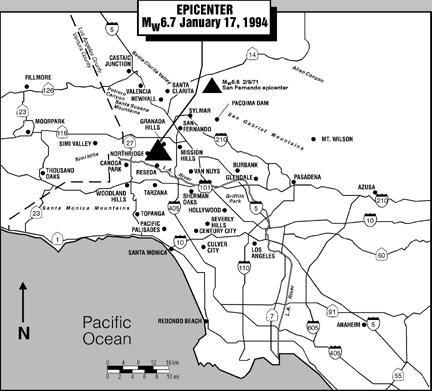
Map of the epicentral area.
Introduction
At 4:31 A.M., Pacific Standard Time, on Monday, January 17, a moderate but very damaging earthquake with a moment magnitude (Mw) of 6.7 struck the densely populated San Fernando Valley, in northern Los Angeles. This region has been repeatedlyrocked by moderate to large earthquakes throughout recorded history. Thousands of aftershocks, many in the magnitude 4.0 to 5.0 range, occurred during the next few weeks, further damaging already-affected structures.
The death toll was 57, and more than 1,500 people were seriously injured. A few days after the earthquake, 9,000 homes and businesses were still without electricity; 20,000 were without gas; and more than 48,500 had little or no water. About 12,500 structures were moderately to severely damaged, leaving thousands of people temporarily homeless. Of the 66,546 buildings inspected, 6% were severely damaged (red tagged) and 17% were moderately damaged (yellow tagged). In addition, damage to several major freeways serving Los Angeles choked the traffic system in the days following the earthquake. Major freeway damage occurred up to 32 km from the epicenter. Collapses and other severe damage forced closure of portions of 11 major roads to downtown Los Angeles.
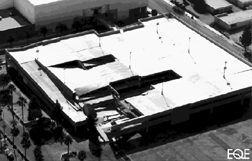
One of two new, precast concrete garages that collapsed at Northridge Fashion Center.
Most damage was caused by shaking, but ground failure and several dozen fires triggered by the earthquake also caused substantial damage. There were extremely strong ground motions--among the strongest ever recorded. This strong shaking and the epicenter's location within the densely built-up San Fernando Valley were major contributors to the large losses.
This earthquake occurred in one of the most well-prepared regions of the United States. Most of the structures in the affected area were built during the past three decades and were considered to be reasonably earthquake resistant. The percentage of buildings totally destroyed by the strong ground motion was very small, and most of the serious damage occurred within about 16 km of the epicentral area.
-
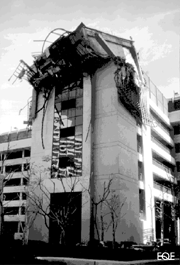

Left: The badly damaged tower of a new parking garage stair structure.
Right: Office buildings in the epicentral area had extensive damage to interior fixtures and furnishings.
Because the earthquake occurred in the early morning and on a holiday, its effects were dramatically reduced from what they could have been. Any of several building collapses each could have caused hundreds of fatalities at a different time of day. Business losses were also moderated by the timing of the earthquake, as most manufacturing and service industries were closed down, and on-the-job injuries were minimized. Further, many businesses had strengthened older buildings before the earthquake, dramatically reducing the potential losses.
This was the third very destructive earthquake to occur in California in the last 23 years. The first was the Mw 6.6 San Fernando (Sylmar) Earthquake, affecting the same area in 1971; the second was the Mw 6.9 (Richter magnitude 7.1), 1989 Loma Prieta Earthquake south of San Francisco. The 1994 event is the most damaging earthquake to strike the United States since the San Francisco Earthquake of 1906. In terms of financial loss, the earthquake is also one of the worst natural disasters in U.S. history, comparable to Hurricane Andrew in 1992.
Geography and Seismicity
Northridge is about 32 km northwest of downtown Los Angeles and is within the suburban San Fernando Valley, which is a sprawling region of residential neighborhoods, apartment complexes, low-rise business and industrial parks, and shopping malls. The area's biggest and best-known geologic fault, the San Andreas, passes about 100 km to the east and north of the San Fernando Valley.
The earthquake occurred on a thrust fault along the northern fringes of the valley. The near-record strong ground motion generated by the earthquake was an indication of the significant risk presented by thrust-fault events of moderate magnitude. Accelerations in the range of 1.0g were recorded over a large area. Similar accelerations, including large vertical accelerations, have been recorded in the past, but at isolated locations and in very limited numbers. Numerous detailed EQE investigations have pointed out that such ground motions were typical in the epicentral areas of many past earthquakes, particularly thrust-type earthquakes such as those in San Fernando in 1971, Coalinga in 1983, Chile in 1985, New Zealand in 1987, and Armenia in 1988.
While this is a major earthquake in terms of its damage, there is no indication that its occurrence has reduced the probability for a stronger earthquake in the next 30 years on a major fault in the Los Angeles region. The probabilities remain in the range of 5% to 10% per year that a major earthquake will strike Southern California. It will be most destructive if it strikes on a major fault such as the Newport-Inglewood Fault or on the San Andreas Fault in the vicinity of Riverside.
1971 San Fernando Earthquake and Comparison to 1994 Earthquake
This was the second time in 23 years that this region has been affected by a strong earthquake. On February 9, 1971, a magnitude 6.6 event struck the San Fernando Valley, about 32 km northeast of the epicenter of the 1994 event. The 1971 earthquake caused 58 fatalities and about 2,000 injuries. At the time, the 1971 earthquake was the most destructive event to affect greater Los Angeles since the magnitude 6.3 Long Beach Earthquake of 1933, and it prompted an extensive reevaluation and update of the building codes. Direct damage to buildings and other structures exceeded $0.5 billion (1971 dollars).
-
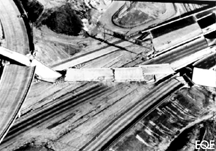
A collapsed overpass from the 1971 San Fernando Earthquake.
This interchange (Interstate 5 and State Route 14) was also badly damaged in the 1994 Northridge Earthquake.
The San Fernando Valley was a recently developed suburban area in 1971. More than 90% of its houses and other buildings were constructed after the first earthquake design requirements had been incorporated into the local building code in 1933. The greatest number of earthquake-related fatalities occurred in the collapse of several 1920s and 1930s concrete-frame buildings at a hospital.
Building damage in the 1994 Northridge Earthquake was widespread, including collapses of both old and new structures. Damage south of the Hollywood Hills was relatively spotty and was concentrated in older buildings and on softer soils--except in Santa Monica, located directly south of the epicentral area, which had extensive damage. Significant structural damage was reported up to 77 km from the epicenter.
The major difference between the two events was their location. The 1971 shock was centered in the middle of the San Gabriel Mountains and released most of its energy in lightly inhabited areas. It caused strong ground shaking only at the northeastern end of the valley. In contrast, the 1994 event was centered within the San Fernando Valley, with a population of some 3 million. This resulted in far greater damage. The timing of the 1994 earthquake, however, kept the number of fatalities to about the same as in 1971.
-
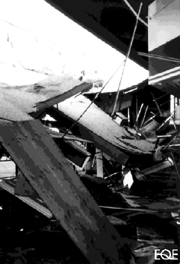
The roof collapsed in this strip shopping mall concrete tilt-up.
Types of Damage
While many in the earthquake engineering profession were not surprised by the type of damage seen, the general public was shocked by its extent and severity. It is not generally understood that many older buildings have not been strengthened to current code requirements, and that the goal of most current code requirements for new buildings is to prevent loss of life in an earthquake, not to protect the investment in a structure or its contents. Further, there are no requirements for privately owned buildings to be retrofitted to current standards, other than some municipal requirements to improve the earthquake resistance of old unreinforced masonry buildings.
This earthquake also caused extensive destruction of building interiors. Because of the intense shaking and heavy damage to other building elements, sprinkler piping was frequently severed and systems were rendered useless on a much wider scale than has been seen in other earthquakes. Interior partitions, furniture, ceilings, and HVAC and other equipment were destroyed with a thoroughness never before seen on such a scale.
Soft (very flexible) stories, which current building codes attempt to discourage, collapsed and caused loss of life. Concrete-frame buildings and concrete parking structures were seriously damaged, and many collapsed. Steel high rises and other steel buildings generally performed well, although there was significant and widespread damage to a number of steel buildings throughout the area. Concrete tilt-ups, including many office buildings, failed in great numbers.
Retrofit Programs and Code Changes
Probably the most important lesson of this earthquake was that seismic strengthening and risk-reduction programs proved very effective, both in saving lives and in maintaining business operations. Companies that had implemented such programs in the San Fernando Valley can point to some major successes. Several large companies that had strengthened their buildings beforehand had minimal business interruption and avoided substantial losses, potentially totaling in the hundreds of millions of dollars in some cases.
Older concrete-frame buildings frequently present a greater risk than do unreinforced masonry buildings, because they are typically larger and house many more people. To prevent these structures from causing fatalities in the future, it seems reasonable to require retrofitting of such privately owned structures on some prioritized basis, consistent with their occupancy and risk level. A similar program of retrofitting soft-story wood-frame apartment buildings may also be needed. The State of California has already established a retrofit program for its public buildings.
The earthquake caused spectacular collapses and dramatic failures of major modern structures, including new structures. New reinforced concrete garages and many relatively new tilt-up concrete and other buildings collapsed or were severely damaged. The Uniform Building Code, which controls the design of new structures in California, may need major revisions in order to reflect the lessons from this earthquake.
Revisions to the code currently under consideration, if accepted, will for the first time offer options to build for levels of resistance greater than the basic goal of ensuring life safety. Several levels of earthquake resistance may be codified that are intended to give engineers and owners the opportunity to design a structure to ensure usability after an earthquake. In addition to reducing or eliminating business interruption, these higher levels of resistance will also provide an extra margin of life safety.
-
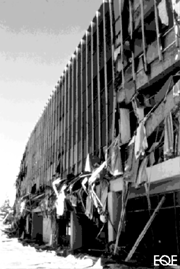
The second story of this concrete-frame building collapsed, bringing the rest of the building down on top of it.
Implications for Other Regions
This earthquake is a warning not only to the rest of California, but to all earthquake regions. The record ground accelerations for a metropolitan region and the damage that they caused in about 15 seconds can occur in or near major cities throughout the world, including all densely populated areas of the Pacific Rim, much of the Mediterranean and Balkans, and much of the Middle East. In the United States, this applies not only to California but to the Pacific Northwest (both of the United States and Canada), the Central Mississippi Valley, the Salt Lake City area, the Charleston area, and other earthquake-prone regions of the country.
A similar earthquake in Seattle, Vancouver, Salt Lake City, or near Saint Louis, for example, would cause far more significant damage to those cities because structures there are typically designed for much lower seismic forces, if any, than are comparable buildings in the San Fernando Valley. In addition, these and other cities adopted seismic-resistive building codes at much later dates. Many buildings, including modern structures and high rises, could collapse.
In metropolitan Tokyo, a similar earthquake would subject a far greater number of buildings than those in the San Fernando Valley to very high accelerations, possibly accelerations well beyond those used by Japanese building codes for new construction. Much of the new construction in Japan is structural steel and is expected to perform reasonably well. However, Tokyo also has tens of thousands of older, reinforced concrete buildings much like the older concrete buildings that collapsed in the San Fernando Valley. Further, much of Tokyo, and particularly much of the industry that encircles the waterfronts along Tokyo Bay, is built on soft soil and fill. Many of these soft soils and landfills will dramatically amplify the ground motion and are likely to fail through liquefaction.
-
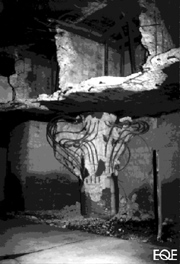
A column from the badly damaged Santa Monica Freeway (Interstate 10).
Conclusion
Every earthquake provides us with lessons. The Northridge Earthquake did not yield significant new lessons, and it is encouraging to note that our knowledge of how structures behave in earthquakes is converging rather than diverging. The performance of some steel buildings was the one area that was somewhat surprising, but in general those structures that experienced seismic engineers expected to perform well in fact did perform well. Changes should be forthcoming to future editions of the building code, but they will generally be based on knowledge we have had for some time. The challenge is to convince building owners, developers, architects, and government officials that engineering and construction costs to develop more earthquake-resistant buildings are cost-effective and practical. The long-term benefits are worth the up-front investment. With this earthquake and the Loma Prieta Earthquake, we have examples that show beyond doubt that investing in retrofits for existing, vulnerable buildings will yield safety and financial benefits.